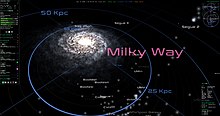盖亚天空
 盖亚天空中的土星和它的卫星 | |
| 原作者 | Toni Sagristà Sellés |
|---|---|
| 开发者 | Toni Sagristà Sellés |
| 首次发布 | 2014年 |
| 当前版本 | 3.5.5-2(2023年10月4日)[1] |
| 源代码库 | codeberg |
| 编程语言 | Java, GLSL |
| 操作系统 | Linux、MacOS和Microsoft Windows |
| 文件大小 | Linux: 51 MB macOS: 105 MB Windows: 96 MB tar.gz package: 48 MB Source code: 27.1 MB |
| 类型 | 教育软件 太空模拟器 |
| 许可协议 | Mozilla公众授权条款 |
| 网站 | zah |
盖亚天空(英语:Gaia Sky)是一款开源天文学可视化和VR程序,拥有Windows、Linux和MacOS版本。它由天文学计算研究所(ZAH,海德堡大学)盖亚小组的托尼·萨格里斯特·塞莱斯(Toni Sagristà Sellés)创建和开发,属于欧空局的盖亚任务框架,旨在创建银河系十亿颗恒星的多元地图。盖亚天空是盖亚数据处理与分析联盟外扩工作组的产物。 该软件在Mozilla公共许可证下发布。

论文《盖亚天空:浏览盖亚目录》(Gaia Sky: Navigating the Gaia Catalog)详细描述了程序的内部运作[2]。
盖亚天空提供了许多高级功能,包含立体(3D)、天文馆、全景渲染器等模式。它还可以配合SteamVR与虚拟现实耳机使用[3],可使用Python编写脚本[4],并支援游戏控制器,甚至可以使用赛车方向盘操作[5]。
欧空局使用盖亚天空来协助盖亚数据发布(Gaia Data Releases)的视频制作[6][7][8]。一段由盖亚天空制作的视频也发布在每日一天文图的网站上[9]。
数据[编辑]

盖亚天空的安装程序包没有包含任何数据,使用者至少还需要下载低分辩率材质的太阳系基本数据集。盖亚天空提供内置下载管理器,连接到海德堡天文学计算研究所的服务器以获取所需的数据集。下载和部署过程对用户来说是无缝的。
程序有几个数据集可用,提供更高分辩率的材质、盖亚EDR 3星表的不同片段(高达14.6亿颗恒星)、其它恒星星表,如依巴谷星表、不同的星系图(尘埃、HII区域等)、星云或河外星系表,例如NBG[10]或史隆数位巡天。
数据集皆存储于易于理解的JSON文件中,并有详尽的文档说明[11]。
参考资料[编辑]
- ^ Gaia Sky Downloads. Gaia Sky. Zentrum für Astronomie Heidelberg. [18 October 2023].
- ^ Sagristà, Antoni; Jordan, Stefan; Müller, Thomas; Sadlo, Filip. Gaia Sky: Navigating the Gaia Catalog. IEEE Transactions on Visualization and Computer Graphics. Jan 2019, 25 (1): 1070–1079. PMID 30130201. S2CID 52055837. doi:10.1109/TVCG.2018.2864508.
- ^ Explore the Milky Way in VR with Gaia Sky. The Irish Times (IT). [29 March 2021].
- ^ Navigate the galaxy with Gaia Sky. Download CREW. [29 March 2021].
- ^ Using an iRacing setup for Gaia Sky. Youtube. Google. [29 March 2021].
- ^ Visualising the Gaia data with Gaia Sky. Gaia Cosmos. ESA. [29 March 2021].
- ^ Bridge of stars. Gaia Cosmos. ESA. [29 March 2021].
- ^ The acceleration of the Solar System with respect to the distant Universe. Gaia Cosmos. ESA. [29 March 2021].
- ^ Here comes the Sun. Astronomy Picture of the Day. ASD at NASA. [9 December 2019].
- ^ Nearby Galaxies Catalog. NBG. [9 October 2019].
- ^ Gaia Sky data formats. Gaia Sky documentation. Zentrum für Astronomie Heidelberg. [9 October 2019].
